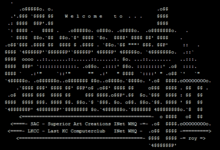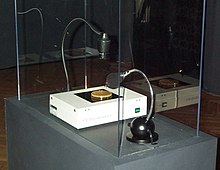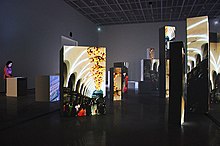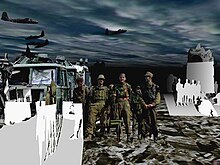New media art



New media art includes artworks designed and produced by means of
New Media art has origins in the worlds of science, art, and performance. Some common themes found in new media art include databases, political and social activism, Afrofuturism, feminism, and identity, a ubiquitous theme found throughout is the incorporation of new technology into the work. The emphasis on medium is a defining feature of much contemporary art and many art schools and major universities now offer majors in "New Genres" or "New Media" and a growing number of graduate programs have emerged internationally.[1]
New media art may involve degrees of interaction between artwork and observer or between the artist and the public, as is the case in performance art. Several theorists and curators have noted that such forms of interaction do not distinguish new media art but rather serve as a common ground that has parallels in other strands of contemporary art practice.[2] Such insights emphasize the forms of cultural practice that arise concurrently with emerging technological platforms, and question the focus on technological media per se. New Media art involves complex curation and preservation practices that make collecting, installing, and exhibiting the works harder than most other mediums.[3] Many cultural centers and museums have been established to cater to the advanced needs of new media art.
History
This section needs additional citations for verification. (September 2015) |
The origins of new media art can be traced to the moving image inventions of the 19th century such as the phenakistiscope (1833), the praxinoscope (1877) and Eadweard Muybridge's zoopraxiscope (1879). From the 1900s through the 1960s, various forms of kinetic and light art, from Thomas Wilfred's 'Lumia' (1919) and 'Clavilux' light organs[4] to Jean Tinguely's self-destructing sculpture Homage to New York (1960) can be seen as progenitors of new media art.[5]
Steve Dixon in his book Digital Performance: New Technologies in Theatre, Dance and Performance Art argues that the early twentieth century avant-garde art movement Futurism was the birthplace of the merging of technology and performance art. Some early examples of performance artists who experimented with then state-of-the-art lighting, film, and projection include dancers Loïe Fuller and Valentine de Saint-Point. Cartoonist Winsor McCay performed in sync with an animated Gertie the Dinosaur on tour in 1914. By the 1920s many Cabaret acts began incorporating film projection into performances.[5]
Robert Rauschenberg's piece Broadcast (1959), composed of three interactive re-tunable radios and a painting, is considered one of the first examples of interactive art. German artist Wolf Vostell experimented with television sets in his (1958) installation TV De-collages. Vostell's work influenced Nam June Paik, who created sculptural installations featuring hundreds of television sets that displayed distorted and abstract footage.[5]
Beginning in Chicago during the 1970s, there was a surge of artists experimenting with video art and combining recent computer technology with their traditional mediums, including sculpture, photography, and graphic design. Many of the artists involved were grad students at The School of the Art Institute of Chicago, including Kate Horsfield and Lyn Blumenthal, who co-founded the Video Data Bank in 1976.[6] Another artists involved was Donna Cox, she collaborated with mathematician George Francis and computer scientist Ray Idaszak on the project Venus in Time which depicted mathematical data as 3D digital sculptures named for their similarities to paleolithic Venus statues.[7] In 1982 artist Ellen Sandor and her team called (art)n Laboratory created the medium called PHSCologram, which stands for photography, holography, sculpture, and computer graphics. Her visualization of the AIDS virus was depicted on the cover of IEEE Computer Graphics and Applications in November 1988.[6] At the University of Illinois in 1989, members of the Electronic Visualization Laboratory Carolina Cruz-Neira, Thomas DeFanti, and Daniel J. Sandin collaborated to create what is known as CAVE or Cave Automatic Virtual Environment an early virtual reality immersion using rear projection.[8]
In 1983,


Simultaneously advances in biotechnology have also allowed artists like Eduardo Kac to begin exploring DNA and genetics as a new art medium.[12]
Influences on new media art have been the theories developed around interaction,
Themes
In the book New Media Art, Mark Tribe and Reena Jana named several themes that contemporary new media art addresses, including computer art, collaboration, identity, appropriation, open sourcing, telepresence, surveillance, corporate parody, as well as intervention and hacktivism.[13] In the book Postdigitale,[14] Maurizio Bolognini suggested that new media artists have one common denominator, which is a self-referential relationship with the new technologies, the result of finding oneself inside an epoch-making transformation determined by technological development.
New media art does not appear as a set of homogeneous practices, but as a complex field converging around three main elements: 1) the art system, 2) scientific and industrial research, and 3) political-cultural media activism.[15] There are significant differences between scientist-artists, activist-artists and technological artists closer to the art system, who not only have different training and technocultures, but have different artistic production.[16] This should be taken into account in examining the several themes addressed by new media art.
Non-linearity can be seen as an important topic to new media art by artists developing interactive, generative, collaborative, immersive artworks like Jeffrey Shaw or Maurice Benayoun who explored the term as an approach to looking at varying forms of digital projects where the content relays on the user's experience. This is a key concept since people acquired the notion that they were conditioned to view everything in a linear and clear-cut fashion. Now, art is stepping out of that form and allowing for people to build their own experiences with the piece. Non-linearity describes a project that escape from the conventional linear narrative coming from novels, theater plays and movies. Non-linear art usually requires audience participation or at least, the fact that the "visitor" is taken into consideration by the representation, altering the displayed content. The participatory aspect of new media art, which for some artists has become integral, emerged from Allan Kaprow's Happenings and became with Internet, a significant component of contemporary art.
The inter-connectivity and interactivity of the internet, as well as the fight between corporate interests, governmental interests, and public interests that gave birth to the web today, inspire a lot of current new media art.
Databases
One of the key themes in new media art is to create visual views of databases. Pioneers in this area include Lisa Strausfeld, Martin Wattenberg[17] and Alberto Frigo.[18] From 2004–2014 George Legrady's piece "Making Visible the Invisible" displayed the normally unseen library metadata of items recently checked out at the Seattle Public Library on six LCD monitors behind the circulation desk.[19] Database aesthetics holds at least two attractions to new media artists: formally, as a new variation on non-linear narratives; and politically as a means to subvert what is fast becoming a form of control and authority.
Political and social activism
Many new media art projects also work with themes like politics and social consciousness, allowing for
Afrofuturism
Afrofuturism is an interdisciplinary genre that explores the African diaspora experience, predominantly in the United States, by deconstructing the past and imagining the future through the themes of technology, science fiction, and fantasy. Musician Sun Ra, believed to be one of the founders of Afrofuturism, thought a blend of technology and music could help humanity overcome the ills of society.[21] His band, The Sun Ra Arkestra, combined traditional Jazz with sound and performance art and were among the first musicians to perform with a synthesizer.[22] The twenty-first century has seen a resurgence of Afrofuturism aesthetics and themes with artists and cooperation's like Jessi Jumanji and Black Quantum Futurism and art educational centers like Black Space in Durham, North Carolina.[23]
Feminism and the female experience
Japanese artist Mariko Mori's multimedia installation piece Wave UFO (1999–2003) sought to examine the science and perceptions behind the study of consciousness and neuroscience. Exploring the ways that these fields undertake research in a materially reductionist manner. Mori's work emphasized the need for these fields to become more holistic and incorporate incites and understanding of the world from philosophy and the humanities.[24] Swiss artist Pipilotti Rist's (2008) immersive video installation Pour Your Body Out explores the dichotomy of beauty and the grotesque in the natural world and their relation to the female experience. The large-scale 360-degree installation featured breast-shaped projectors and circular pink pillows that invited viewers to relax and immerse themselves in the vibrant colors, psychedelic music, and partake in meditation and yoga.[24] American filmmaker and artist Lynn Hersman Leeson explores in her films the themes of identity, technology and the erasure of women's roles and contributions to technology. Her (1999) film Conceiving Ada depicts a computer scientist and new media artist named Emmy as she attempts and succeeds at creating a way to communicate through cyberspace with Ada Lovelace, an Englishwoman who created the first computer program in the 1840s via a form of artificial intelligence.[25]
Identity
With its roots in outsider art, New Media has been an ideal medium for an artist to explore the topics of identity and representation. In Canada, Indigenous multidisciplinary artists like Cheryl L'Hirondelle and Kent Monkman have incorporated themes about gender, identity, activism, and colonization in their work.[26] Monkman, a Cree artist, performs and appears as their alter ego Miss Chief Eagle Testickle, in film, photography, painting, installation, and performance art. Monkman describes Miss Chief as a representation of a two-spirit or non-binary persona that does not fall under the traditional description of drag.[27]
Future of new media art
The emergence of 3D printing has introduced a new bridge to new media art, joining the virtual and the physical worlds. The rise of this technology has allowed artists to blend the computational base of new media art with the traditional physical form of sculpture. A pioneer in this field was artist Jonty Hurwitz who created the first known anamorphosis sculpture using this technique.
Longevity
As the technologies used to deliver works of new media art such as
Methods of preservation exist, including the translation of a work from an obsolete medium into a related new medium,
Around the mid-90s, the issue of storing works in digital form became a concern. Digital art such as moving images, multimedia, interactive programs, and computer-generated art has different properties than physical artwork such as oil paintings and sculptures. Unlike analog technologies, a digital file can be recopied onto a new medium without any deterioration of content. One of the problems with preserving digital art is that the formats continuously change over time. Former examples of transitions include that from 8-inch floppy disks to 5.25-inch floppies, 3-inch diskettes to CD-ROMs, and DVDs to flash drives. On the horizon is the obsolescence of flash drives and portable hard drives, as data is increasingly held in online cloud storage.[31]
Museums and galleries thrive off of being able to accommodate the presentation and preservation of physical artwork. New media art challenges the original methods of the art world when it comes to documentation, its approach to collection and preservation. Technology continues to advance, and the nature and structure of art organizations and institutions will remain in jeopardy. The traditional roles of curators and artist are continually changing, and a shift to new collaborative models of production and presentation is needed.[32]
Preservation
see also Conservation and restoration of new media art
New media art encompasses various mediums all which require their own preservation approaches.[3] Due to the vast technical aspects involved no established digital preservation guidelines fully encompass the spectrum of new media art.[33] New media art falls under the category of "complex digital object" in the Digital Curation Centre's digital curation lifecycle model which involves specialized or totally unique preservation techniques. Complex digital objects preservation has an emphasis on the inherent connection of the components of the piece.[34]
Education
In New Media programs, students are able to get acquainted with the newest forms of creation and communication. New Media students learn to identify what is or isn't "new" about certain technologies.[35] Science and the market will always present new tools and platforms for artists and designers. Students learn how to sort through new emerging technological platforms and place them in a larger context of sensation, communication, production, and consumption.
When obtaining a bachelor's degree in New Media, students will primarily work through practice of building experiences that utilize new and old technologies and narrative. Through the construction of projects in various media, they acquire technical skills, practice vocabularies of critique and analysis, and gain familiarity with historical and contemporary precedents.[35]
In the United States, many Bachelor's and Master's level programs exist with concentrations on Media Art, New Media, Media Design, Digital Media and Interactive Arts.[36]
Theorists and historians
Notable art theorists and historians working in this field include:
Types
The term New Media Art is generally applied to disciplines such as:
- Artistic computer game modification
- ASCII art
- Bio Art
- Cyberformance
- Computer art
- Critical making
- Digital art
- Demoscene
- Digital poetry
- Electronic art
- Experimental musical instrument building
- Evolutionary art
- Fax art
- Generative art
- Glitch art
- Hypertext
- Information art
- Interactive art
- Kinetic art
- Light art
- Motion graphics
- Net art
- Performance art
- Radio art
- Robotic art
- Software art
- Sound art
- Systems art
- Telematic art
- Video art
- Video games
- Virtual art
Artists
Cultural centres
- Australian Network for Art and Technology
- Center for Art and Media Karlsruhe
- Centre pour l'Image Contemporaine
- Daniel Langlois Foundation
- Eyebeam Art and Technology Center
- Foundation for Art and Creative Technology
- Gray Area Foundation for the Arts
- Harvestworks
- InterAccess
- Los Angeles Center for Digital Art (LACDA)
- Netherlands Media Art Institute
- NTT InterCommunication Center
- Rhizome (organization)
- RIXC
- School for Poetic Computation (SFPC)
- School of the Art Institute of Chicago
- Squeaky Wheel: Film and Media Arts Center
- V2 Institute for the Unstable Media
- WORM
See also
- ART/MEDIA
- Artmedia
- Aspect magazine
- Culture jamming
- Digital media
- Digital puppetry
- Electronic Language International Festival
- Expanded Cinema
- Experiments in Art and Technology
- Interactive film
- Interactive media
- Intermedia
- LA Freewaves
- Net.art
- New media art festivals
- New media artist
- New media art journals
- New media art preservation
- Remix culture
- VJing
References
- S2CID 55958365.
- ^ "Contemporary Art and New Media: Toward a Hybrid Discourse?". 15 February 2011.
- ^ .
- S2CID 57568475.
- ^ ISBN 978-0-262-52752-1.
- ^ a b Cox et al. 2018, p. 50-70.
- ^ Cox et al. 2018, p. 165–169.
- ^ Cox et al. 2018, p. 85-91.
- ^ "La Plissure du Texte". 1904.cc. Archived from the original on 2015-04-02.
- ^ "Nouveaux Media – New Media – Neue Medien". www.newmedia-art.org.
- ISBN 978-0-262-07279-3.
- ^ Kac, E. (2007). "Art that looks you in the eye: hybrids, clones, mutants, synthetics, and transgenics". Signs of life: Bio art and beyond. MIT Press. pp. 1–27.
- ISBN 978-3-8228-2537-2
- ISBN 978-88-430-4739-0
- ISBN 978-88-7336-564-8.
- ^ Maurizio Bolognini (2010). From interactivity to democracy. Towards a post-digital generative art. Artmedia X Proceedings, Paris.
- ^ Bulajic, Viktorija Vesna (2007). Database aesthetics: art in the age of information overflow. University of Minnesota Press.
- ^ Moulon, Dominique (2013). Contemporary new media art. Nouvelles éditions Scala.
- ISSN 0024-094X.
- ISBN 978-1-137-43362-6.
- ISBN 978-1-61374-799-5.
- ISBN 978-1-4773-1117-2.
- S2CID 239684575.
- ^ ISBN 978-1-4529-5511-7.
- ^ Kinder, M. (2005). "A cinema of intelligent agents: conceiving ada and teknolust". In Tromble, M. (ed.). The art and films of lynn Hershman leeson: Secret agents, private. University of California Press. pp. 167–181.
- S2CID 194059689.
- ISSN 0161-6463.
- ^ "Digital Rosetta Stone" (PDF). ercim.org.
- ^ Rinehart, Richard. "Preserving the Rhizome ArtBase (report)". rhizome.org. Archived from the original on 2005-01-16.
- ISSN 0362-4331. Retrieved 2016-11-14.
- ^ "Longevity of Electronic Art". besser.tsoa.nyu.edu. Retrieved 2017-12-07.
- OCLC 225871513.
- S2CID 109627137.
- .
- ^ a b "The School of Art and Design – University of Illinois at Urbana-Champaign". illinois.edu. Archived from the original on 2016-03-02. Retrieved 2013-04-30.
- ^ "New Media Programs in the United States — Dr. Edgar Huang". www.iupui.edu.
Further reading
- ISBN 0-262-23227-8.
- ISBN 978-2-916571-64-5.
- Timothy Murray; ISBN 978-2-35988-046-5.
- Bush, Vannevar (1945-07-01). "As We May Think". The Atlantic. Archived from the original on 2012-08-22.
- ISBN 978-0-520-21803-1.
- Barreto, Ricardo; Perissinotto, Paula (2002). The Culture of Immanence. INTERNET ART FILE 2002, São Paulo, IMESP. ISBN 85-7060-038-0. Archived from the original(DOC) on 2008-06-25.
- Jorge Luis Borges (1941). "The Garden of Forking Paths." Editorial Sur.
- ISBN 978-2-37896-371-2.
- ISBN 2-7384-8262-7.
- Buci-Glucksmann, Christine (2002). La folie du voir: Une esthétique du virtuel (in French). Paris: Editions Galilée. ISBN 978-2-7186-0599-9.
- Catricalà, Valentino (2015-01-01). "Media Art. Towards a New Definition of Arts in the Age of Technology". Academia.edu.
- Graham, Beryl; ISBN 978-0-262-01388-8.
- "Curating New Media – Beryl Graham & Sarah Cook on the challenges of exhibiting massless media". Art Monthly. No. 261. November 2002.
- Cook, Sarah (2010). A Brief History of Curating New Media Art – Conversations with Curators. Berlin: Damaris Publishing. ISBN 978-3-941644-20-5.
- Cook, Sarah (2010). A Brief History of Working with New Media Art – Conversations with Artists. Berlin: The Green-Box-Kunst-Ed. ISBN 978-3-941644-21-2.
- Fleischmann, Monika; ISBN 978-3-934013-38-4.
- Fleischmann, Monika; Strauss, Wolfgang, eds. (2001). CAST01//Living in Mixed Realities. ISSN 1618-1387.
- Shapiro, Alan N. (2010). "Preface". In Gatti, Gianna Maria (ed.). The Technological Herbarium. Avinus Verlag. ISBN 978-3-86938-012-4.
- ISBN 978-1-86189-143-3.
- ISBN 978-0-262-02653-6.
- Graham, Philip Mitchell, New Epoch Art, InterACTA: Journal of the Art Teachers Association of Victoria, Published by ACTA, Parkville, Victoria, No 4, 1990, ISSN 0159-9135, Cited In APAIS. This database is available on the Informit Online Internet Service or on CD-ROM, or on Australian Public Affairs – Full Text
- Grau, Oliver (2003). Virtual Art: From Illusion to Immersion. Cambridge (Mass.): Mit Press. ISBN 0-262-07241-6.
- Grau, Oliver (2007). MediaArtHistories. Cambridge, Mass: MIT Press. ISBN 978-0-262-07279-3.
- Hansen, Mark (2004). New Philosophy for New Media. Cambridge, Mass.: MIT Press. ISBN 978-0-262-08321-8.
- Higgins, Dick (February 1966). "Intermedia". The Something else Newsletter. 1 (1).
- Lopes, Dominic McIver. (2009). A Philosophy of Computer Art. London: Routledge
- ISBN 0-262-63255-1.
- Manovich, Lev (2002). "Ten Key Texts on Digital Art: 1970-2000". Leonardo. 35 (5). MIT Press - Journals: 567–575. S2CID 57566892.
- ISBN 978-0-262-23227-2.
- Mondloch, Kate (2010). Screens: Viewing Media Installation Art. Minneapolis, Minn: University of Minnesota Press. ISBN 978-0-8166-6522-8.
- Paul, Christiane (2003). Digital Art. London: Thames & Hudson. ISBN 0-500-20367-9.
- Paul, Christiane (2007-01-27). "Challenges for a Ubiquitous Museum: Presenting and Preserving New Media". NeMe.
- Robert C. Morgan, Commentaries on the New Media Arts Pasadena, CA: Umbrella Associates,1992
- Janet Murray (2003). "Inventing the Medium", The New Media Reader. MIT Press.
- Frank Popper (2007) From Technological to Virtual Art, MIT Press/Leonardo Books
- Frank Popper (1997) Art of the Electronic Age, Thames & Hudson
- Edward Shanken (2009-02-09). "Writings on Contemporary Art and New Media".
- Shanken, Edward A. (2009-02-21). Art and Electronic Media. London New York [Lagny-sur-Marne]: Phaidon. ISBN 978-0-7148-4782-5.
- Tribe, Mark; Jana, Reena (2009). New Media Art. Basic art series. Taschen. ISBN 978-3-8365-1413-2. Archived from the originalon 2010-07-05.
- Usselmann, Rainer (2003). "The Dilemma of Media Art: Cybernetic Serendipity at the ICA London". Leonardo. 36 (5). MIT Press - Journals: 389–396. S2CID 263470200.
- Rainer Usselmann, (2002) "About Interface: Actualisation and Totality", University of Southampton
- Wands, Bruce (2006). Art of the Digital Age. London: Thames and Hudson. ISBN 0-500-23817-0.
- Whitelaw, Mitchell (2006). Metacreation: Art and Artificial Life. Cambridge, Mass London: MIT Press. ISBN 0-262-73176-2.
- Dietz, Steve (2004-02-16). "Collecting New Media Art: Just Like Anything Else, Only Different". NeMe.
- Worms, Anne-Cécile (2008). Arts Numériques: Tendances, Artistes, Lieux et Festivals (in French). M21 Editions. ISBN 978-2-916260-33-4. Archived from the originalon 2018-06-25.
- Youngblood, Gene (1970). Expanded Cinema. New York. E.P. Dutton & Company.
- Prada, Juan Martín (2012-04-12). Prácticas artísticas e internet en la época de las redes sociales (in Spanish). Ediciones Akal, S.A. ISBN 978-84-460-3517-6.
- New Media Faculty, (2011). "New Media", University of Illinois at Urbana-Champaign
- Hiekel, Jörn Peter (2009). Vernetzungen: Neue Musik im Spannungsfeld von Wissenschaft und Technik (in German). Institut für Neue Musik und Musikerziehung Darmstadt. OCLC 320198124.
- Bailey, Chris; Gardiner, Hazel (2016-04-08). Revisualizing Visual Culture. Routledge. ISBN 978-1-317-06349-0.
- Hudson, Dale; Zimmermann, Patricia R. (2009). "Taking things apart: Migratory archives, locative media, and micropublics". Afterimage. 36 (4): 14–19. .
- Moss, Ceci (2008-12-03). "Thoughts on "New Media Artists vs Artists With Computers"". Rhizome.
- Nechvatal, Joseph (2013-08-20). "Whither Art? David Joselit's Digital Art Problem". Hyperallergic.
- Joselit, David (2013). After Art. Princeton: Princeton University Press. ISBN 978-0-691-15044-4.
- Guertin, Carolyn (2012-04-26). Digital Prohibition: Piracy and authorship in new media art. London: Continuum. ISBN 978-1-4411-0610-0.
- Catricalà, Valentino (2013-01-01). "Come l'avanguardia inventò il futuro. L'Optofono di Raoul Hausman, la "visione elettromeccanica di Lissitzky e le forme dell'energia" [How the avant-garde invented the future. The Raoul Hausmann’s Optophone, the Lissitzky‘s "electromecchanic vision" and the shapes of energies]. In "Imago. Rivista di studi sul cinema e i media" (in Italian).
- Hudson, D.; Zimmermann, P. (2015-04-09). Thinking Through Digital Media: Transnational Environments and Locative Places. Palgrave Macmillan. ISBN 978-1-137-43362-6.
- Strehovec, Janez; Baldwin, Sandy (2016-10-08). Text as Ride: Electronic Literature and New Media Art. Computing Literature. West Virginia University Press. OCLC 959956315.
- Cox, D.; Sandor, E.; Fron, J.; Wainwright, L.; Balsamo, A.; Malloy, J.; Cruz-Niera, C.; Bushell, C.; Goggin, N.; Rasmussen, M. (2018). New Media Futures: The Rise of Women in the Digital Arts. University of Illinois Press. ISBN 978-0-252-05018-3.
